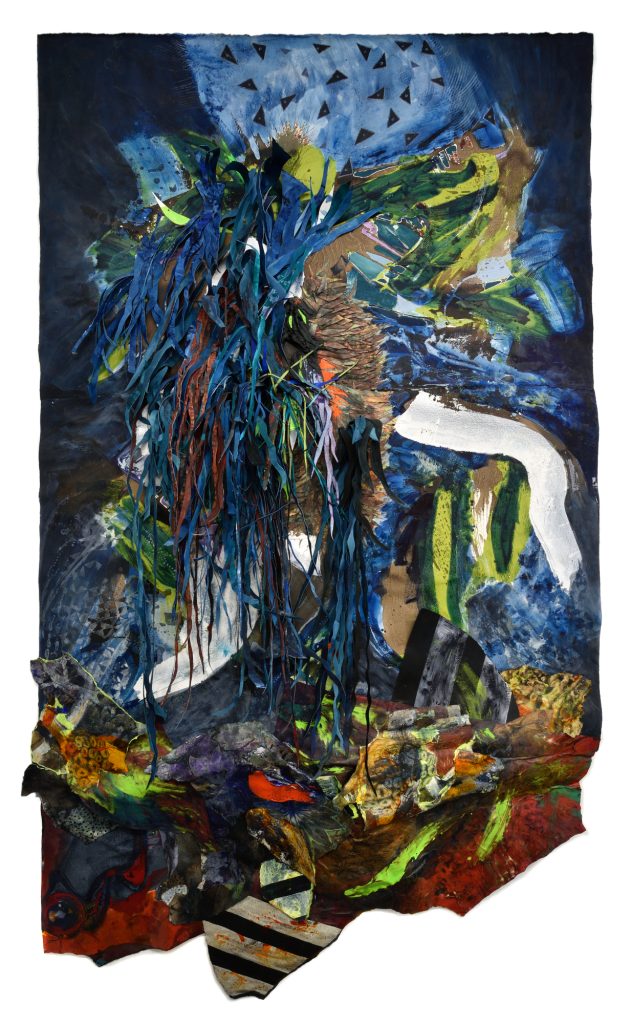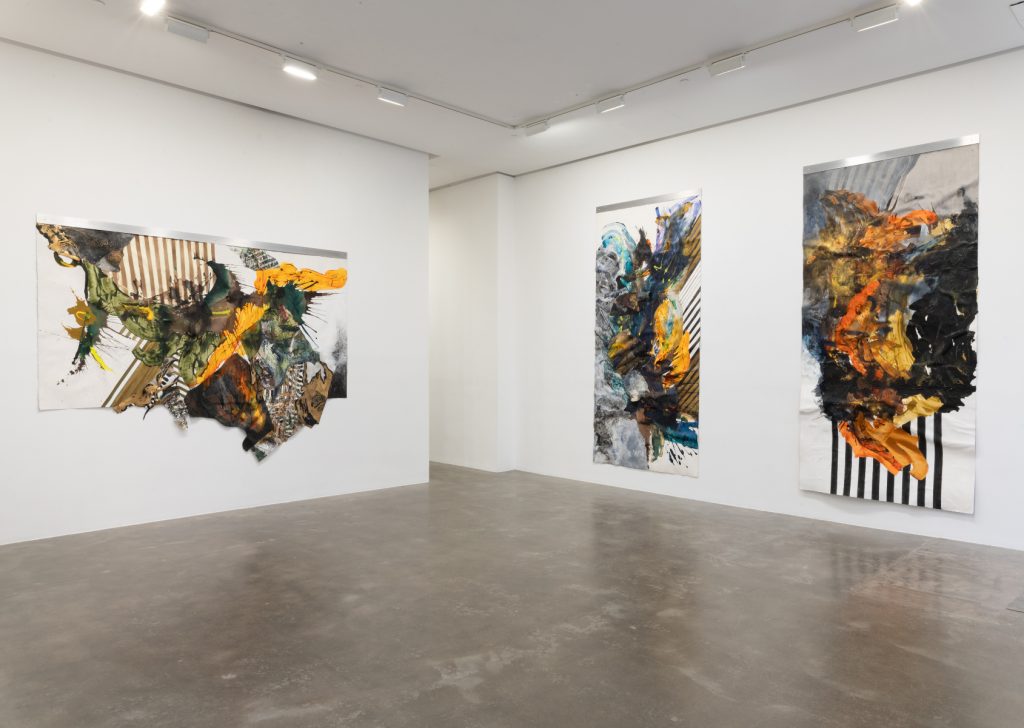I was enraptured by the exhibition “Martha Jackson Jarvis: What The Trees Have Seen II,” which just recently drew to a close at Susan Inglett Gallery in New York City.
As explained by the gallery, Jarvis was looking back towards “her great-great-great-great grandfather’s experience as a free Black militia man during the American Revolutionary War” when creating the exhibited works. This exhibition’s title positions it as an accompaniment to an exhibition of the artist that closed in March of this year at the Baltimore Museum of Art.
Martha Jackson Jarvis’ Sweeping Art
Jarvis’ works simultaneously are (logistically, not thematically) abstract painting and layered assemblage, freely moving between layers of material evoking a particular perspective on the passage of time and expansive, passionate bursts of pigment.
And at times, they’re large. “Crossing Land” (2020), which was also in that museum showcase, is a full 12 feet in width, layering Arches cold press 300 lb paper and canvas and featuring black walnut ink, oil, acrylic, and watercolor.
More rigid stripes sit alongside forceful splashes of orange and forest green, a piercing, sudden surge of development that feels beyond the individual and their control. It’s something dramatic, stark, unexpected, somber, and far-reaching. Perhaps there was serious calamity — or at least the threat of it — in the experience of “crossing land” to which the artwork is pointing.
In any case, the piece weaves individualized sensation and experience into a more expansive, enveloping process — a story, with an environment pushing against the central occupant and sending them spinning. There are multiple theaters of confrontation, and the reach of what you might imagine as history itself is pressing back on those in the fight. But the central perspective is pushing right back, creating something perhaps surprisingly stirring and decidedly majestic against the backdrop of that grandiose, potentially destabilizing drama.
That look towards the massive scale of history was made clear by the artworks themselves on top of the explanations for the series from the gallery and other sources.
Jarvis constructs conceptual scenes in which grandly scaled, internally fueled characters-of-sorts meet and enter into communal dialogue. The forms and progressions of the artist’s particular visual choices suggest inevitability and an external hand — something arriving and compelling a reckoning, whether big in scale or more personal. Shifting, slipping, but also hulking forms moving across the surface — these construct the sense that externally originating forces are meeting and adding to each other. The exhibition’s “trees” put forward an opportunity for enriching connection that’s met on the other side by the traveler or travelers moving through the area. Jarvis’ works shine and grow.

Moving Onward Through History
Ultimately, if there’s one thing that’s consistent across Jarvis’ assemblage-fueled artworks, it’s a sense of progress — a feeling of movement, of establishing yourself in a place and the sweeping ambition that comes before that point. She plants the personal and the grand. It’s all enveloped and begins to move forward.
The aesthetic churn as Jarvis blends materials and colors in artworks that move towards you suggests a hard fought, even tearing desire and determination behind the journey — physical or not — underway. It’s a visually, tactilely expressed push and an aesthetic processional that build upon themselves, with a sense of cultivated certainty.
You could imagine that as a powerful communication of the resolute ambition that must have been necessary for Jarvis’ forebear to participate in the American Revolution.
In the art, she moderates the grand and overarching — both in literal, physical size and aesthetic impact — with the personal and trudging, a resounding, reverberating process of building one moment, one interaction, and one step atop the next.
In this artist’s work, it’s a process that’s itself permeable but is persistent, taking sweeping tension and pushing it forward. Smaller moments alongside bigger ones all land and remain what I see as, from one vantage point, aesthetically circulating among themselves, pointing to the passage of time as a constructed process: suites of imperfect layering, with something slipping, perhaps — but it’s there, and it’s staying.
You feel in Jarvis’ art that what we understand as “history” is itself a living, assembled process that contains the work of many individuals: an inevitability on par with the passage of time itself that was nonetheless reshaped and reassembled by many hands throughout it. It’s like a river that remains flowing but bears a memory of those who’ve visited.
The clouds of blue across “Keep the Blue of Light of Home” (2020) suggest not only that specific connection but also those grand forces as still reaching out towards us: a welcoming cascade of color and texture that is moving forwards, offering a link with the past while living the present.
Logistically, there is simply a lot going on across Jarvis’ artworks, but the ultimate feeling is nonetheless one also of earned triumph. Though the artist’s aesthetic components are internally weighty, they stand together, ultimately.
The artworks’ pull together more than they pull apart, offering a vision of some reassuring and emotionally buoying story emerging from the clashes of history, fogged by the march of time. The strength blends and builds across Jarvis’ artworks, creating moments of synchronicity amid the towering and maybe even overpowering forces.
It’s a vision of hope, I think. It’s imagining forces of nature (like Jarvis’ forebear and his surroundings) meeting and, between them, a story taking shape.


Featured image: MARTHA JACKSON JARVIS, Installation view, “What The Trees Have Seen II” at Susan Inglett Gallery, NYC. 17 October — 30 November 2024. Photo: Adam Reich; Courtesy of the artist and Susan Inglett Gallery, NYC.
You may also like
-
Diana Kurz at Lincoln Glenn in New York: A Review of a Shining Art Exhibition
-
Dustin Hodges at 15 Orient in New York City: An Ensnaring Exhibition at an Exciting Gallery
-
Maren Hassinger at Susan Inglett Gallery in New York: Reviewing an Uplifting Art Exhibition
-
Enzo Shalom at Bortolami in New York City: Reviewing an Entrancing Exhibition of Paintings
-
“Ben Werther: Townworld” at Amanita in New York City: Reviewing a Richly Memorable Art Exhibition
